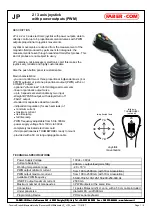
Technical Reference
Manual Tuning
For optimum control
performance, tune the
1500 to the
themal system. The tuning
settings
here are meant for a broad spectrum of applications; your
system may
have
somewhat
different requirements.
Refer to the key
flow
charts,
diagrams and defini-
tions on Pages 42 - 61 for prompt location and description. Repeat this tuning
procedure for both Channel 1 and 2.
NOTE:
When tuning in
the Heat mode, use H where X appears.
When tuning In the Cool mode, use C where X appears.
1.
Apply
power
to
the Series 1500 and
enter a set point in the Change Data Mode
(CHG DATA). Next,
go
into the Change Parameter Mode
(CHG PARA), and
enter (1) at
the GA parameter. Using the MODE, UP/DOWN
and ENTER
keys,
set the operating parameters initially:
l
Proportional Band: 1X P b = O
l
Cycle Time:
!
1 X C T = 5
.
Reset:
l
1 X RS = 0.00
l
Dead Band: 1X
d b = O
.
Rate: 1X RT = 0.00
l
Caiibration Offset: 1X CA = 0
l
Rate Band: 1X Rb = 3.00
To tune a parameter relating to heat, set the set point above ambient temperature,
for cooling, set the set point below ambient temperature. Allow actual process tern-
perature to stabilize at
or near set point.
The ACTUAL display indicates when the
load is stabilized near set point.
2.
3.
4.
5.
6.
Proportional Band Adjustment: Gradually increase Pb until the
ACTUAL
display
temperature stabilizes to a constant value. The temperature will not be right on
set point because the initial reset value is 0.00 repeats per minute. The
ACTUAL
temperature will stabilize below the desired set point. (When Pb = 0, RS, Rb,
RT, and Ct are inoperative, and the 1500 functions as a simple ON/OFF
control
with a 3°F/1.7°C
switching differential.
Reset Adjustment: Gradually increase
RS
until the ACTUAL display temperature
begins to oscillate or “hunt.” Then slowly decrease RS until the ACTUAL display
stabilizes again near set point. NOTE: This is a slow procedure, taking
from
minutes to hours to obtain optimum value.
Rate Adjustment: Increase RT
to
1
.OO min. Then raise set
point by 20° to 30°F/
11° to 17°C. Observe the system’s
approach to set point. lf the bad
tempera-
ture overshoots set point, increase RT to 2.00 minutes.
Cycle Time Adjustment: Set CT as required. Optimum system controls is always
achieved with faster cycle times. However, if a mechanical contactor or solenoid
is switching power to the load,
a longer cycle time may be desirable
to minimize
wear on the mechanical components.
Experiment
until the cycle time
is consis-
tent with the quality of control you want.
Calibration Offset Adjustment: You may
want your system to control
to a tem-
perature other than the value
coming from the input
sensor. If so, measure the
difference (as much as ±90°F/±50°C)
between
that temperature, perhaps
at
another point in the system, and the
process value showing in
the alphanumeric
display. Then enter the amount of CAL Offset
YOU want
Calibration offset adds
or subtracts degrees from the value of
the input signal.
Tuning, Chapter
4
WATLOW Series 150O
User's Manual
59
















































